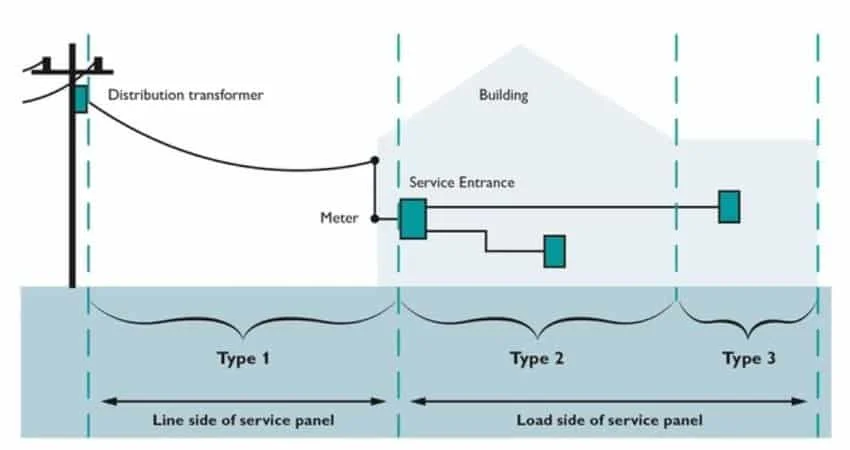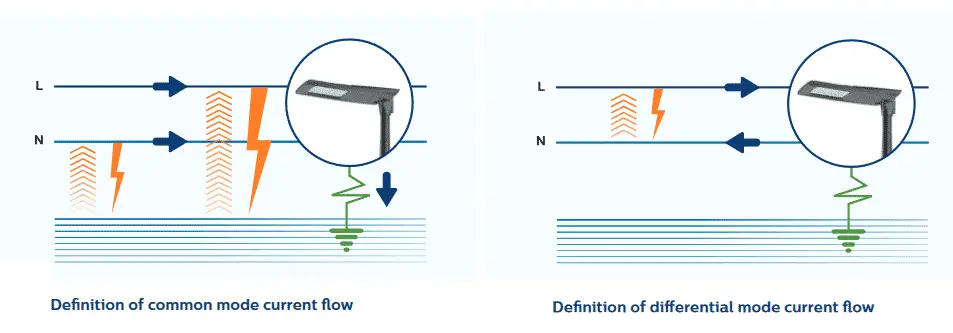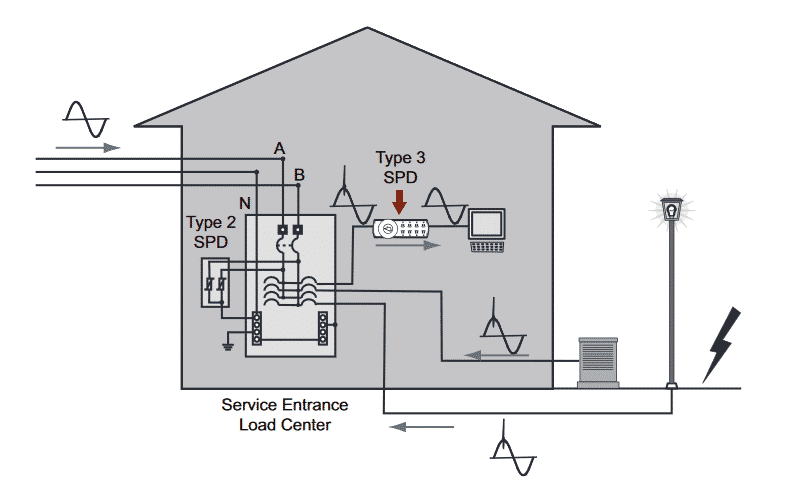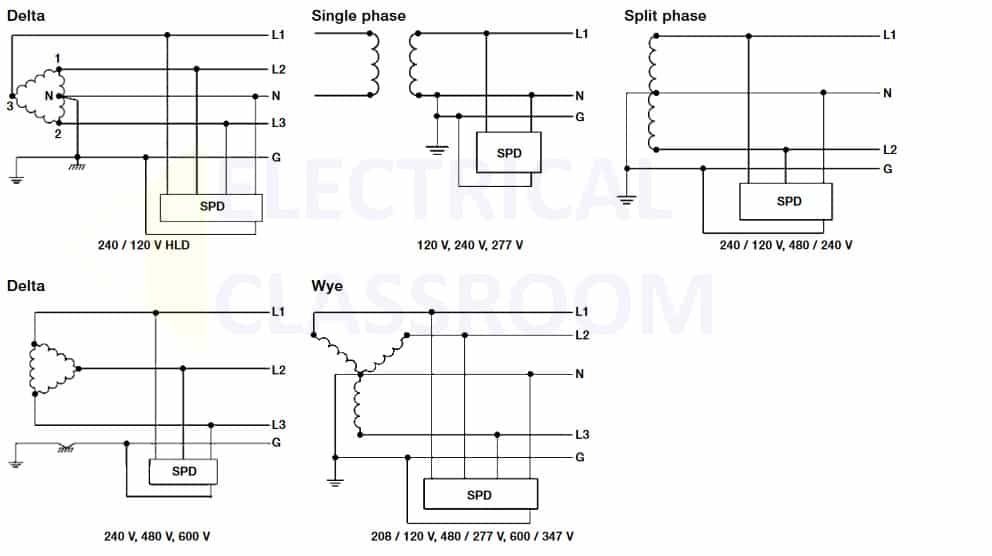A surge protection device (SPD) or simply a surge protector is a device used to ensure protection against transient surges. It is used to protect the household and commercial applications from voltage transients. It is connected in parallel to the load it has to protect.
What is a transient surge?
A transient surge is a sudden increase in power (voltage and current) that lasts for a few microseconds. The magnitude of the surge ranges between 1.1 times to 12 times the normal system voltage.
What are the causes of transient surges?
Transient surges can be a result of sudden changes either within the system or the external environment. The internal causes include load switching and the operation of heavy loads. Sudden load changes result in a change in load currents which results in overvoltages or sometimes voltage surges.
Lightning is the major external reason for transient surges. Installations directly hit by lightning or indirectly hit through underground distribution cables suffer huge damage or at least some disturbing effects. Apart from lightning switching of equipment such as transformers, and motors, sudden load variations, and circuit breaker operations may also induce transient surges into the distribution networks.
If homes and commercial buildings were left unprotected, it may result in the following:
- Equipment failures.
- Operation shutdown.
- Damage to the communication system.
- In the worst-case scenario, fire and danger to life.
What are surge protection devices or surge protectors?
SPD are devices used to ensure protection from the above-stated dangers caused by transient surges. They are capable of safely diverting the transients to the earth. Surge protectors connected in parallel have a high impedance. This impedance drops as transient voltages appear in the system so that the current can be driven to the earth through them. The usage of these devices is stressed in IEC 60364-4-44 and IEC 60364-5-53.

Types of SPD
The following are the various types of Surge protection devices:
- Type 1/Class I
- Type 2/Class II
- Type 3/Class III
Type 1: Surge protection devices that can discharge partial lightning current of typically 10/350µs waveform. They are installed before the main isolation device in the load center, typically between the transformer’s secondary and the load center’s main circuit breaker. They are used in building with an installed lightning protection system and can protect against partial lightning currents resulting from direct hit lightning. Type 1 devices usually use spark gap technology and are commonly referred to as surge arresters.
Type 2: This type of SPDs are meant for installation within the main distribution board of residential and commercial establishments. Best suited for protection against switching transients and indirect lightning, characterized by an 8/20 μs current wave. Combines Type-1 and Type-2 devices are also available in the market. Type 2 devices usually use metal oxide varistor technology.
Type 3: This type of SPDs are used to protect household appliances from the surges generated within the home. They are also known as point-of-use surge protectors. They have a very less discharge current rating – a minimum of 3kA. They are installed close to the load, say socket outlets, and act as a supplement to Type-2 SPDs.
Type 4: Type 4 protection constitutes one or more surge suppressors along with short circuit protection devices and is used suitable for printed circuit boards.
Type 5: The components such as MOVs used in the design of surge protectors.
Principle of operation
The principle of surge protection is pretty straightforward. Whenever a transient surge reaches an installed SPD, it gets diverts the surges to the earth. This helps in limiting the amplitude of the surge and minimizing the damages caused to the electrical installations. Two modes of surge protection: Common mode and differential mode protection.

Common mode protection:
Protection against transient surges appearing between phase or neutral conductor and the earth (i.e.) phase-earth or neutral-earth. The common-mode overvoltages can damage the installations connected to the earth. In the event of such overvoltages, the surge protection device transfers the energy directly to the earth.
Differential mode protection:
Protection against transient surges appearing between the phase and the neutral conductors. Such overvoltages are more dangerous and can damage all equipment connected to the supply. In the event of such overvoltages, the energy can be transferred to the ground or the other live conductor.
SPD Ratings
Nominal System Voltage (Uo)
The line-to-earth voltage of the system for which the device is designed to operate.
Maximum Continuous Operating Voltage (Uc)
The maximum RMS phase to the neutral voltage the device is designed to operate.
Nominal discharge Current
The peak 8/20μs current waveform that the device can safely discharge a minimum of 19 times. The higher the nominal current, the longer will be the life of the device.
Short circuit current rating (SCCR)
The maximum symmetrical fault current that the device can withstand without causing any functional hazard is called a short circuit current rating.
Impulse current (Iimp)
The maximum impulse current that the surge protection device can withstand during transient surges. IEC 62305 mandates a maximum impulse current rating of 25kA per pole.
Voltage Protection Level ( Up):
The voltage protection level determines the transient voltage limiting the capacity of the SPD. The lower the voltage protection level, the more effective will be the device’s response to voltage transients.
Connection of Surge Protection Device
Different SPD connection configuration is shown in the picture below:
Usually, the SPD is connected before the incomer of the main circuit board. The device must be not more than 10 meters from the incoming circuit breaker. If the distribution board has a metallic enclosure, the earth connection can be made directly to the enclosure. In the case of a non-metallic enclosure, the connection has to be made with the auxiliary earth block. Also, the installation cable length should not exceed 0.5 meters.



Very elaborate contain on SPD & Useful information, we Every Spare Parts are well known and realizable supplier of SPD, please find below link to our shop for your SPD requirements.
Useful and informative article on SPDs.We provide the solutions of lightning and sureg protection: repsun.com.cn